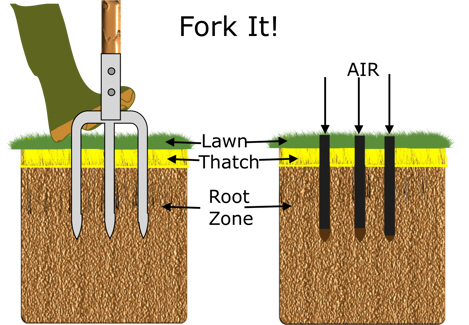
We can appreciate a good lawn from what we see of it above the ground but we need to understand that a healthy lawn relies on conditions below the ground. There are several reasons to put as many holes as possible into your lawn.
Aeration
Plant roots and soil organisms need air.
Compaction
A solid layer in the root zone will stop the lawn draining. If water can’t run to the drains the roots sit in water and rot.
Thatch
Dead plant material builds up at the base of grass plants. It is called thatch. Thatch can become a thick dense mat that stops rainfall or irrigation penetrating into the root zone.
Root growth
Roots grow easily in the space provided by aeration holes. Deeper roots feed the lawn and help it survive drought.
Micro-organisms
Beneficial fungi and bacteria within soil are aerobic (they need air) Harmful ones are anaerobic (bacteria that live without oxygen).
When we push holes into turf we allow an exchange of gas in the root zone. In poorly aerated soil anaerobic bacteria produce poisonous gas such as methane and hydrogen sulphide. Holes in turf allow air in and unwanted gas out. If your lawn smells of bad eggs when you push a fork into it the conditions below ground are anaerobic.
A good soil sustains large populations of aerobic bacteria. These bacteria digest organic matter and excrete soluble substances that provide nutrition for plants. Thatch is literally digested by aerobic bacteria.
Puddles on your lawn are a sign of compaction. High levels of use or traffic on a lawn is one cause. If there are areas of standing water that disappear rapidly following a fork then the lawn is almost certainly suffering from compaction. If following a fork standing water remains a problem the underlying drainage is in question. You may need to put land drains deep into the soil profile. In most cases a deep fork will correct problems of standing water.
Roots are the mechanism plants use to anchor them to the ground and collect nutrition. The more root your lawn has the stronger it will be. Roots grow more easily within aerated soil. Factors of stress and wear caused by games, tents pitched for weeks or drought are less of an issue if a healthy root system develops underground. Deep rooted grass will recover from events that might kill plants with shallow roots.
Forking before over seeding is a good idea. New root growth from young seedlings channels easily down the holes. A rake after a spike closes the surface openings and seed will settle into the remaining indentations.
Not all lawn spikes are the same. A shallow tine can be 7.5 to 15cm (3 – 6 inches deep). A deep tine can be down to 30 or 35cm (12 – 14 inches).
Solid tines or hollow?
A hollow tine takes out thatch and introduces air without squashing the root zone sideways. For a small lawn a garden fork is sufficient. The deeper the tines the better, grass roots often stop at the depth of aeration.
Push straight in and out or push straight in and lever and out?
To introduce air the tines go in and come straight out. On compacted areas particularly unwanted footpaths you can lift the lawn up a few centimetres by using the fork as a lever. Push the fork in and pull back to 45° before exit.
Spike during wet or dry weather?
Always spike in dry weather. Particularly on clay soils metal tines smear. This means the clay sets and seals each tine hole. In dry weather the clay will crack and accentuate the benefits of aeration (add more air).
In summary air below the ground is essential for healthy plants. To produce a perfect lawn we need to introduce air into the root zone. A garden fork can achieve this for a small area but for large lawns you might need to hire equipment.




